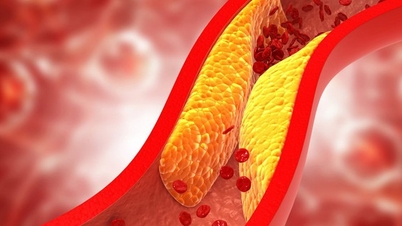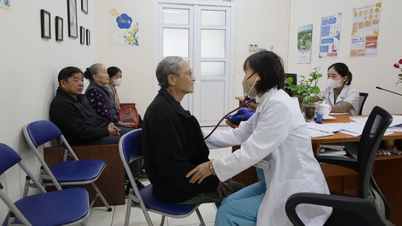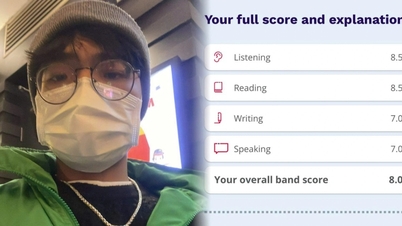Stroke, once considered a "disease of the elderly," is now increasingly affecting younger people, even those under 30.
Sharing on his personal page, Associate Professor Dr. Nguyen Huy Thang, Head of the Department of Cerebrovascular Pathology at People's Hospital 115 and Vice President of the Vietnam Stroke Association, expressed his deep concern about this alarming situation.
Recently, the increasing number of young people hospitalized due to stroke has caused considerable concern among medical professionals (Illustrative image: Getty).
Stroke under age 30
Associate Professor Nguyen Huy Thang said that recently, People's Hospital 115 received a 28-year-old male patient with brain damage that had spread to almost half of the brain hemisphere.
Prior to this, the patient was living a normal life, but suddenly experienced paralysis of the right side of the body and loss of speech after an evening out for dinner with friends.
Although the patient was quickly taken to a nearby hospital, by the time they were transferred to People's Hospital 115, their condition had become critical. There, the patient had to undergo craniotomy surgery to save their life, but the prognosis for neurological function was very poor.
Having recently graduated from postgraduate programs in England and working at a major university, this incident has left the young man's future almost completely bleak.
"Clearly, the boy has no future," Associate Professor Thang shared.
Fortunately, another case involved a 23-year-old sixth-year medical student. He also suffered a stroke but was detected and treated promptly. Thanks to the quick and effective intervention of the medical team, the patient fully recovered and returned to his normal life and studies.
Alarming situation
According to Associate Professor Nguyen Huy Thang, the average age of stroke onset in Vietnam is about 10 years lower than in developed countries, where this figure ranges from 70-75 years old.
In Vietnam, it is not uncommon for stroke patients under 56 years old to suffer strokes, with some cases even occurring in children as young as 15.
Statistics from the World Health Organization (WHO) in 2020 show that Vietnam recorded nearly 160,000 deaths due to stroke, with many cases occurring among young people, especially in developing countries like Vietnam.
The reasons for the increasing number of strokes at younger ages include factors such as unhealthy lifestyles, work stress, smoking habits, alcohol abuse, obesity, and lack of physical activity.
In particular, the use of e-cigarettes – a popular trend among young people – also increases the risk of stroke due to the effects of nicotine on the cardiovascular and nervous systems.
In addition, underlying conditions such as hypertension, diabetes, dyslipidemia, and atrial fibrillation, even without obvious symptoms, are also "silent enemies" that accelerate the risk of stroke in young people.
This led Associate Professor Nguyen Huy Thang to ask a question: "When should we start screening for stroke?"
According to the American Heart Association (AHA) and the American Stroke Association (ASA), stroke risk assessment should begin at age 40 during routine health checkups, focusing on factors such as blood pressure, cholesterol, diabetes, and lifestyle.
However, for those at high risk, screening may be recommended earlier, even before age 40. Groups requiring particular attention include:
- Individuals with a family history: Parents or siblings who have had a stroke or cardiovascular disease since childhood.
- Individuals with underlying medical conditions such as high blood pressure, diabetes, atrial fibrillation, or dyslipidemia.
- High-risk lifestyles such as smoking (including e-cigarettes), obesity, sedentary lifestyle, or alcohol abuse.
- Having had a transient ischemic attack (TIA): This is often an early warning sign of stroke.
Associate Professor Thang noted that the purpose of screening is to detect early risk factors for stroke such as high blood pressure, diabetes, dyslipidemia, atrial fibrillation, or vascular disease.
"In many cases, these conditions may not cause any symptoms beforehand. However, early detection will allow for timely intervention through lifestyle changes, medical treatment, or preventive measures to reduce the risk of stroke," he explained.
Furthermore, screening is only the first step. People need to control risk factors through lifestyle changes, such as eating a healthy diet, exercising regularly, quitting smoking, and having regular health checkups. This is the key to effective stroke prevention.
Source: https://dantri.com.vn/suc-khoe/bac-si-tran-tro-voi-cac-ca-dot-quy-o-nguoi-tre-lam-gi-de-phong-ngua-20250629110034912.htm




![[Photo] Prime Minister Pham Minh Chinh holds a phone call with the CEO of Russia's Rosatom Corporation.](/_next/image?url=https%3A%2F%2Fvphoto.vietnam.vn%2Fthumb%2F1200x675%2Fvietnam%2Fresource%2FIMAGE%2F2025%2F12%2F11%2F1765464552365_dsc-5295-jpg.webp&w=3840&q=75)
![[Photo] Closing Ceremony of the 10th Session of the 15th National Assembly](/_next/image?url=https%3A%2F%2Fvphoto.vietnam.vn%2Fthumb%2F1200x675%2Fvietnam%2Fresource%2FIMAGE%2F2025%2F12%2F11%2F1765448959967_image-1437-jpg.webp&w=3840&q=75)




















































![[OFFICIAL] MISA GROUP ANNOUNCES ITS PIONEERING BRAND POSITIONING IN BUILDING AGENTIC AI FOR BUSINESSES, HOUSEHOLDS, AND THE GOVERNMENT](https://vphoto.vietnam.vn/thumb/402x226/vietnam/resource/IMAGE/2025/12/11/1765444754256_agentic-ai_postfb-scaled.png)




















































Comment (0)